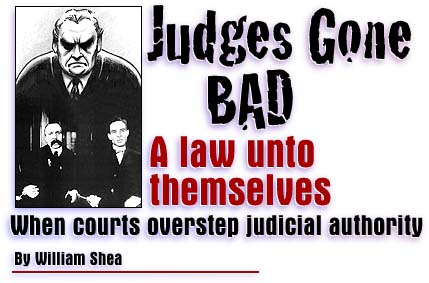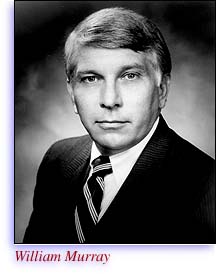

U.S. District Judge Russell Clark held his own firm ideas about how to integrate schools in Kansas City, Missouri, and for 18 years he pursued them — at a cost to the state and the taxpayer of more than $1.5 billion.
To entice more white students from the suburbs into the schools of Kansas City, he sought to create a “model” school district that included state-of-the-art radio and television studios, Olympic-size swimming pools, greenhouses, planetariums and a sophisticated model of the United Nations, complete with all of the needed electronic gadgetry for simultaneous language translations. And he ordered pay raises for teachers and administrators in 1990 and 1992.
 To finance all of this, he doubled taxes on property and ordered a surcharge on income tax. The U.S. Court of Appeals rejected the income tax surcharge, but the property tax increase remained.
To finance all of this, he doubled taxes on property and ordered a surcharge on income tax. The U.S. Court of Appeals rejected the income tax surcharge, but the property tax increase remained.
The results? More dropouts, lower test scores, and fewer non-minority students than ever. Criticism came from all quarters, even from black parents, who resented the push to attract white students, as if black children could not learn on their own.
“It never ceases to amaze me,” stated U.S. Supreme Court Justice Clarence Thomas, “that the courts are so willing to assume that anything that is predominately black must be inferior.”
In a 32-page decision issued in June 1995, the Supreme Court stated that Judge Clark had gone too far in his efforts to attract non-minority students to Kansas City from outside the district. The decision, written by Chief Justice William Rehnquist, cited a lack of evidence that the citizens in the suburbs had created the segregation, and held that the problem should be addressed within the Kansas City School District.

While higher courts are increasingly seeking to curb instances of judges who step beyond the bounds of their powers, and more public officials are protesting their actions, these measures usually come only after much time has passed and many dollars have been spent. Nor are such instances infrequent.
* In 1975, U.S. District Judge Arthur Garrity took over operations of the Boston public schools, overseeing such minutiae as how many basketballs would be purchased. His control terminated 11 years and 416 judicial orders later after court-ordered busing had driven virtually all white students out of the public school system. Blacks said that the desegregation actions, funded by some $130 million, produced no change in racist attitudes and that black children were having more problems than ever before.
The Boston Globe reported in September 1995, “Twenty-one years after Garrity ordered desegregation, the Boston schools remain largely segregated, by race and class, from the mainstream of society.”

The result? Hardly anyone showed up when they were supposed to appear in court. One man, twice charged and twice released, murdered a police officer. A man charged with drunk driving was involved after his release in another car accident that killed a woman and critically injured a second.
The judge took control of the city’s jails, including the finances, in 1986. More than nine years later, she still held the purse strings and oversaw the construction of new facilities.
“It was pretty extraordinary power for a judge to tell a city how to build its courthouse, where the flagpoles should go,” said Philadelphia District Attorney Lynne Abraham, “[and] whether or not the furniture should be Scotch-guarded.”
The proper course, Abraham said, is not for judges to take over the legal system, but to fix the unconstitutional condition. Where courts do intervene, a time limit must be placed on relief. Once the unconstitutional conditions are fixed, the judges should relinquish control.
*Sometimes rulings have sweeping national effects, as the U.S. Supreme Court ruling which banned prayer from public schools.
 William Murray, who with his mother, Madalyn Murray, was the successful plaintiff in the case which resulted in this ban, today feels strongly that prayer needs to be brought back to the schools.
William Murray, who with his mother, Madalyn Murray, was the successful plaintiff in the case which resulted in this ban, today feels strongly that prayer needs to be brought back to the schools.
In a recent interview, Mr. Murray, now a devout Christian, said that the Supreme Court decision to ban prayer contributed to the country’s moral crisis:
“It is the precedent that case set to remove every vestige of faith, religion and morality from our schools. ... In some areas of the country, we have gone past the concept of any reasonable separation of church and state to a position of almost religious repression. Our forefathers intended benevolent neutrality. What we have now in many school systems and in many government agencies is universal hostility toward religion.”
Last year, President Clinton issued an executive order stating that the government had gone too far in taking religion out of the schools. He also endorsed guidelines formulated and published by a broad coalition of religious and civil liberties groups aimed at clarifying the legal rights of students to express religious beliefs and ideas in public schools. (See “Clarifying the Line Between Church and State,” Freedom, Volume 28, Issue 1.)

In her book Injustice for All, attorney and legal commentator Anne Strick wrote, “In our American system of three-way checks and balances, the judicial branch was conceived as equal with executive and legislative power. It is, however, something more.
“All our laws are exactly as effective or useless as those judges who interpret and enforce them,” Strick wrote, and pointed out that whenever a judge decides a case, he is making law.
Indeed, an article in Columbia Law Review called a trial judge “the most important officer of government.” His or her personality, opinions and, in some cases, biases, determine how the law is interpreted, how it is to be administered, and what it actually is.
The selection of properly qualified individuals is therefore crucial.
In the balance can lie hundreds of millions or billions of dollars, as in cases described above — or even life and death. In Massachusetts, for example, in what has been called the “trial of the century,” Nicola Sacco and Bartolomeo Vanzetti, working-class Italian immigrants involved in radical political issues of their day, were accused in 1920 of two murders. A prejudiced judge, Webster Thayer, presided at their trial, systematically shredded the judicial rights of both men, and set a pattern for judicial irresponsibility.
Thayer instructed the jury, for example, that Sacco, “although he may not actually have committed the crime, is nevertheless morally culpable, because he is the enemy of our existing institutions.”
Sacco and Vanzetti were convicted of the murders in 1921. Evidence existed at the time, however, that they were not guilty and that a notorious gang of local criminals had actually been responsible for the murders. In fact, a member of the gang had confessed to the crimes, and independent evidence supported this. Justice Thayer ignored this information and more. He ensured that vital data was withheld from the jury and then refused to allow a new trial to consider the evidence that pointed to their innocence.
Harvard law professor Felix Frankfurter, later to become a U.S. Supreme Court Justice, summarized the case in February 1927:
“By systematic exploitation of the defendants’ alien blood, their imperfect knowledge of English, their unpopular social views, and their opposition to the war [World War I], the District Attorney invoked against them a riot of political passion and patriotic sentiment; and the trial court connived at — one had almost written cooperated in — the process.”
Judge Thayer’s written opinion, Frankfurter stated, was “a farrago of misquotations, misrepresentations, suppressions and mutilations. ... The opinion is literally honeycombed with demonstrable errors, and infused by a spirit alien to judicial utterance.”
Despite impassioned protests by Frankfurter and many others of good will around the nation and the world, on August 23, 1927, two possibly innocent men were electrocuted, primarily because the trial judge — entrusted by the state and by society to uphold the law and the common good — had been blinded by hatred and bigotry. Attorney Charles Curtis later described a visit to Thayer’s chambers when he was settling a case:
“He [Thayer] was standing between me and the window, so that when I looked out ... behind him I saw the top of the Charlestown Jail where the death house was. ... I wasn’t thinking much about it until I realized that Judge Thayer was no longer talking about our case, but strutting up and down boasting that he had been fortunate enough to be on the bench when those sons of bitches were convicted. I had a chill....”
In 1977, 50 years after their deaths, Massachusetts Governor Michael Dukakis issued a proclamation declaring that Nicola Sacco and Bartolomeo Vanzetti had not received a fair trial. The proclamation was intended to remove the “stigma and disgrace” attached to their names.
It was a gesture of decency that unfortunately came far too late.

In some cases, elected leaders today are standing their ground and letting judges know when they have overstepped their authority. When presented with a court order to send his press releases to a spokesman for a group of prisoners, Michigan Governor John Engler refused to do so. Eventually a senior court took the judge off the case.
When Engler sought to shut down a Detroit psychiatric facility, circuit court judges repeatedly barred his efforts. Rusty Hills, a spokesman for the governor, condemned judicial interference as “outrageous and flat-out wrong.” Ultimately, the state appeals court ordered the local judges not to block the governor’s actions.
In the end, improvements in the system will come when citizens, public officials and, perhaps even more importantly, judges themselves, insist that the very highest standards of judicial selection and performance be maintained at all levels of the judiciary and that judges remain one of the three co-equal branches of government — not an omnipotence that overshadows all others.

